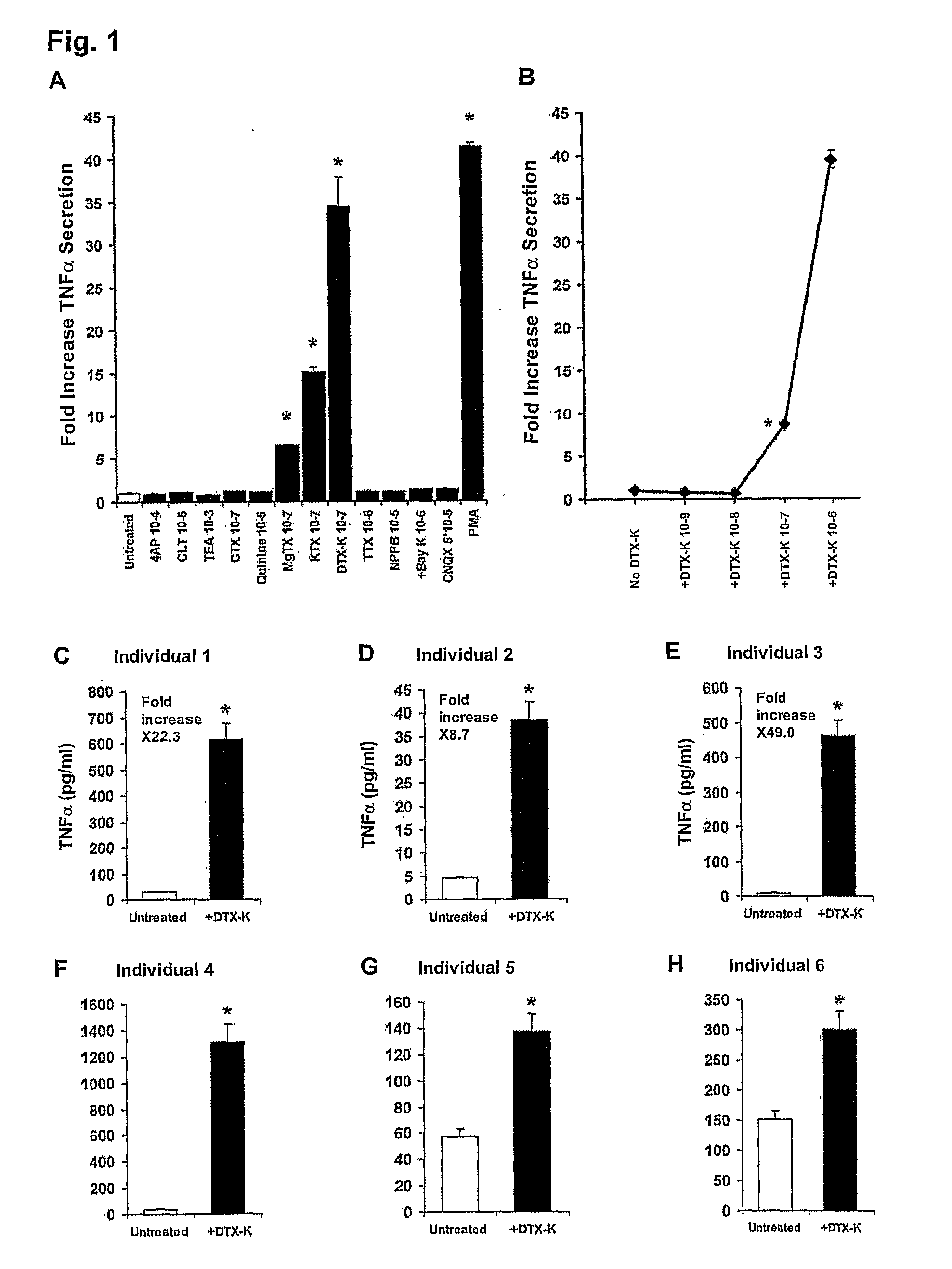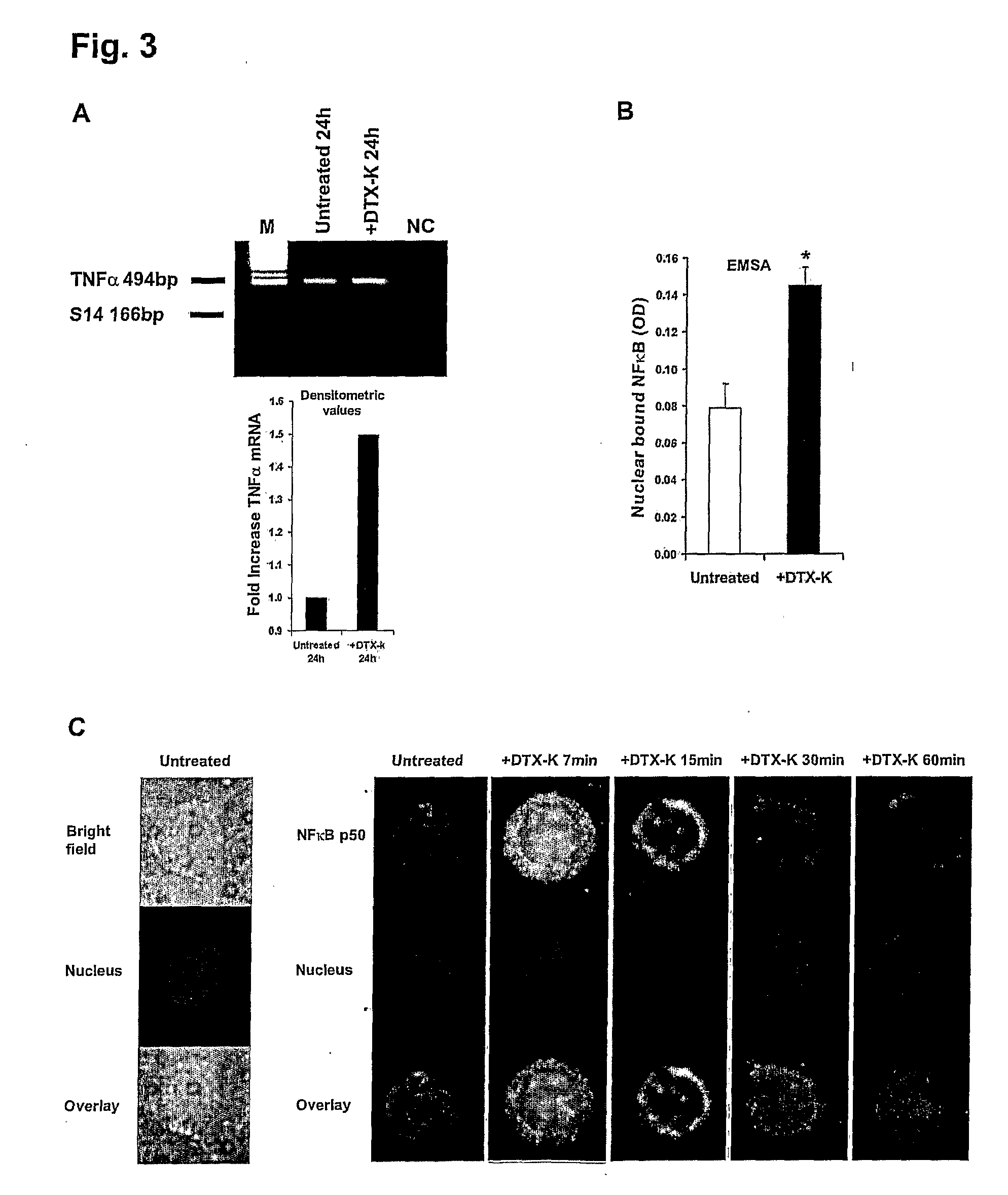MODULATING THE KV1.1 VOLTAGE-GATED POTASSIUM CHANNEL IN T-CELLS FOR REGULATING THE SYNTHESIS AND SECRETION OF TUMOR NECROSIS FACTOR ALPHA (tnf-ALPHA) AND TREATING HUMAN DISEASE OR INJURIES MEDIATED BY DETRIMENTALLY HIGH OR LOW LEVELS OF TNF-ALPHA
a voltage-gated potassium channel and t-cell technology, applied in immunological disorders, metabolism disorders, antibody medical ingredients, etc., can solve the problems of tumor necrosis factor alpha synthesis and secretion is not controlled, and the tumor necrosis factor alpha is not controlled. , to achieve the effect of improving tumor necrosis factor alpha recruitment, increasing the penetration of t-cells, and improving tumor necrosis
- Summary
- Abstract
- Description
- Claims
- Application Information
AI Technical Summary
Benefits of technology
Problems solved by technology
Method used
Image
Examples
example 1
Materials and Methods
[0093]Ion Channel Blockers: See also Table 1. Specified for each ion channel blocker used herein are its full name, its abbreviation and manufacturer in brackets, and its effective concentrations (derived from the respective manufacturer's data sheets and / or the literature). Further detailed information can be found at the International Union of Pharmacology website (see Gutman et al, 2003). The blockers included: 4-Aminopyridine (4-AP, Sigma, St. Louis, Mo.), 10 μM-1 mM; Tetraethylammonium (TEA, Sigma), 100 μM-10 mM; Quinine (Sigma), 1-10 μM; Clotrimazole (CLT, Agis Industries, Bnei Brak, Israel), 10 nM-10 μM; rCharybdotoxin (CTX, Alomone labs, Jerusalem, Israel), 10-100 nM; Kaliotoxin (KTX, Alomone), 1-100 nM; rMargatoxin (MgTX, Alomone), 50 pM-50 nM; Dendrotoxin-K (DTX-K, Alomone), 10-100 nM; Tetrodotoxin (TTX, Alomone), 100 nM-1 μM; NPPB (Tocris Cookson, Avonmouth, UK), 100-200 μM; R-(+)-Bay K8644 (+Bay K, Tocris) 10 nM-1 μM; CNQX (Tocris), 100 nM-50 μM.
TABL...
example 2
Selective Block of Kv1.1 Subunit Containing Channels in Normal Human T-Cells Triggers Marked and Isolated TNF-α Secretion
[0121]Freshly-purified normal human T-cells (“resting” normal human peripheral T-cells) were exposed to 12 different ion channel blockers (see Table 1) in the complete absence of any other stimulating molecules. These 12 blockers were selected on the basis of their reported ability to block most types of K+, Na+, Ca2+ and Cl− channels expressed in T-cells (Deutsch et al, 1986; Lewis et al, 1995; Lewis et al, 1988; Rader et al, 1996; Freedman et al, 1995; Koo et al, 1997; Lin et al, 1993; Ishida et al, 1993; Jensen et al, 1999; Kotturi et al, 2003; Phipps et al, 1996; Verheugen et al, 1997; Levite et al, 2000; Chandy et al, 1984). The levels of TNFα secreted into the culture media were tested 24 hours later by ELISA. For positive control, the cells were exposed to the potent phorbol ester PMA, know to activate T-cells in a non-specific manner. The results are shown...
example 3
Blocking the Kv1.1 Subunit Containing Channels by DTX-K Induces an Exclusive Secretion of TNF-α, while “Classical” TCR-Activation Induces a Robust Yet Non-Exclusive Secretion of TNF-α, IFN-γ, IL-10 and IL-4
[0126]In FIGS. 2A-H, normal human T-cells were either exposed to 100 nM DTX-K (FIGS. 2A-D), or to “classical” TCR-activation using anti-CD3 and anti-CD28 mAbs (FIGS. 2E-H). The levels of TNF-α, IFN-γ, IL-10 and IL-4 secreted to the culture media within the next 24-72 hours were then examined by ELISA. Shown are the fold increases ±SD of TNFα (FIGS. 2A and E, 24 hr), IFN-γ (FIGS. 2B and 2F, 24 hours), IL-10 (FIGS. 2C and 2G, 72 hours) and IL-4 (FIG. 2D and sH, 72 hours) secretion from one representative experiment, of at least three independent experiments performed. Statistical analysis: *P=0.0056 (A), 0.0050 (E), 0.0051 (F), 0.0050 (G) and 0.0053 (H) vs. untreated (Student's t-test).
[0127]Interestingly, it was found that blocking Kv1.1 by DTX-K elevated only TNFα, while not affec...
PUM
| Property | Measurement | Unit |
|---|---|---|
| voltage-gated | aaaaa | aaaaa |
| permeability | aaaaa | aaaaa |
| affinity | aaaaa | aaaaa |
Abstract
Description
Claims
Application Information
 Login to View More
Login to View More - R&D
- Intellectual Property
- Life Sciences
- Materials
- Tech Scout
- Unparalleled Data Quality
- Higher Quality Content
- 60% Fewer Hallucinations
Browse by: Latest US Patents, China's latest patents, Technical Efficacy Thesaurus, Application Domain, Technology Topic, Popular Technical Reports.
© 2025 PatSnap. All rights reserved.Legal|Privacy policy|Modern Slavery Act Transparency Statement|Sitemap|About US| Contact US: help@patsnap.com



